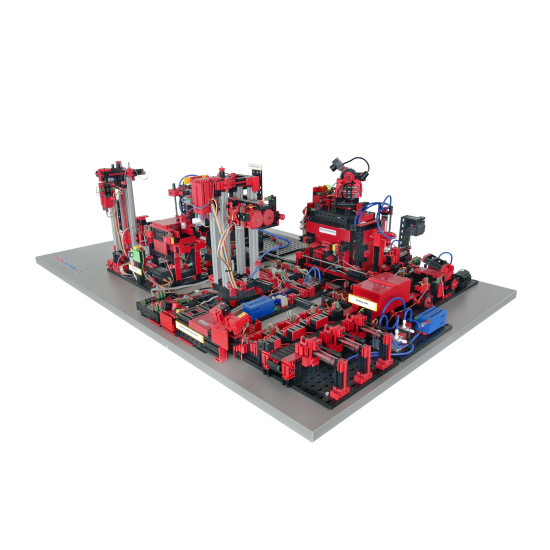
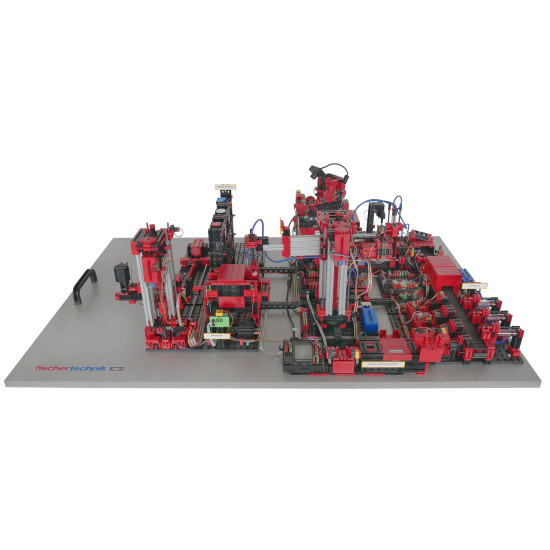
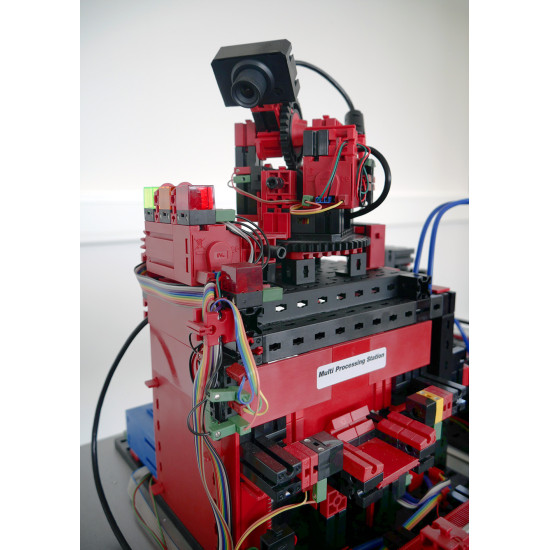
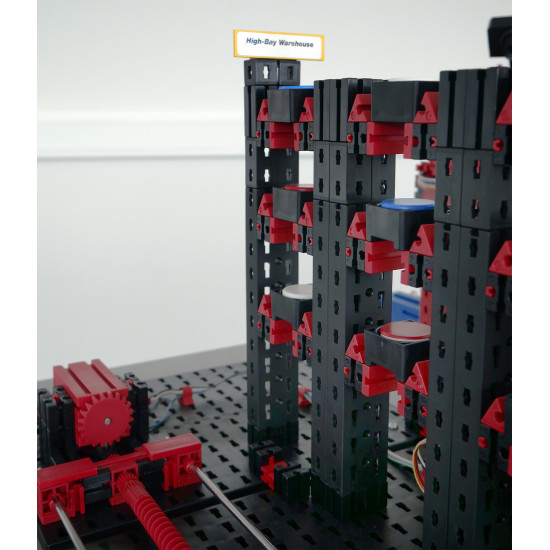
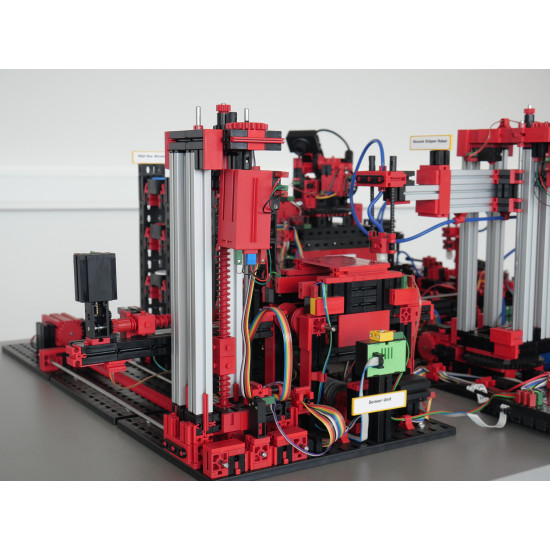
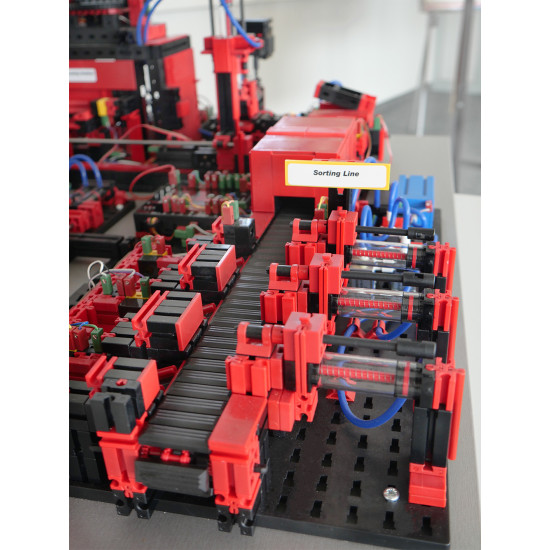
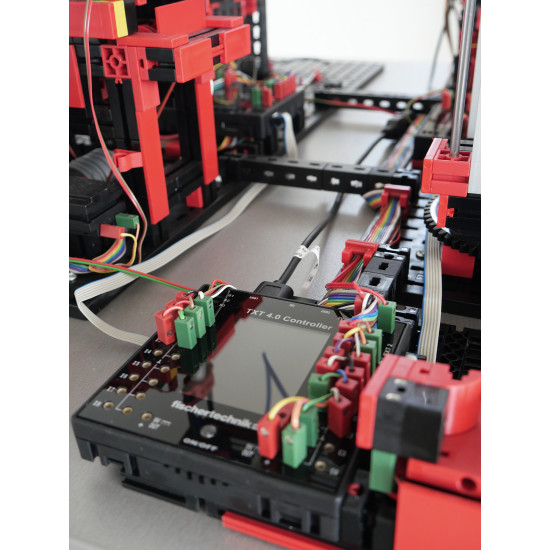
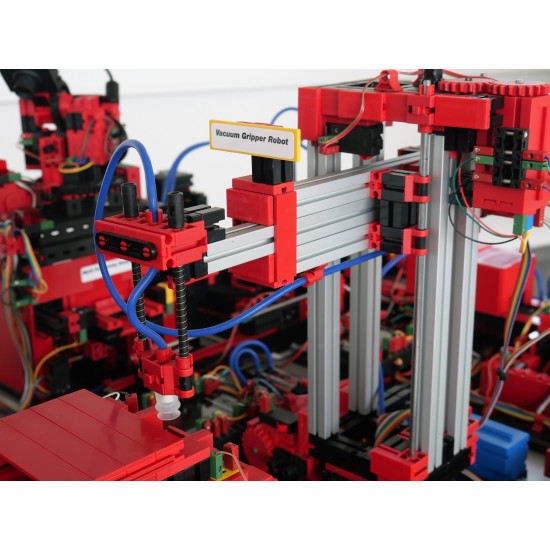








Training Factory Industry 4.0 9V V2 - Simulation
Advantages:
Training and simulation on a realistic production replica, enhanced learning through tactile understanding
Optical and sensory applications, digital traceability with NFC/RFID
Integrated cloud connectivity, control via smart devices, and utilization and operation of dashboards
Remote monitoring via camera possible, as well as linking production and scheduling data
Integration of upstream/downstream logistics processes
The digitally-driven transformation in industrial production demands stronger networking and smarter information at all levels of production. With the fischertechnik Learning Factory 4.0, these digitization activities can be simulated, learned and applied on a small scale before implementation on a larger scale. It is a highly flexible, modular, cost-effective, and robust training and simulation model that can be used in a meaningful way.
The fischertechnik learning environment is designed for learning and understanding Industry 4.0 applications in vocational schools and training, as well as for research, teaching, and development at universities, companies, and IT departments. The simulation replicates the order process, production process, and delivery process in digitized and networked process steps.
Factory environment
This consists of the factory modules of the input and output station, vacuum suction gripper, high-bay warehouse, multi-processing station with furnace, a sorting line with color recognition, an environmental sensor, and a swiveling camera. After the order is placed in the dashboard, the workpieces pass through the respective factory modules, and the current status is immediately visible in the dashboard. The integrated environmental sensor reports values for temperature, humidity, air pressure, and air quality. The camera provides a view of the entire system through its vertical and horizontal pivoting range and can be used for web-based remote monitoring.
Each individual workpiece is tracked through NFC (Near Field Communication): each workpiece receives a unique identification number (ID). This enables the traceability and visibility of the current status of the workpieces in the processing process.
Control
The Lernfabrik 4.0 is controlled by the fischertechnik TXT 4.0 Controller on a 9V basis, of which six are installed. These are connected within the factory according to the master-slave principle and communicate via an internal bus system. The complete performance data of the TXT 4.0 Controller can be viewed at the TXT 4.0 Controller, here are the most important features:
Processor: Arm® dual Cortex®-A7 650 MHz + Cortex®-M4
Memory capacity: 512 MB DDR3 RAM, 4 GB eMMC
Memory expansion: Micro SD card slot
Color touch display: 2.4 ", 320x240 pixels, capacitive (allows swipe gestures)
Flat design, dimensions: 90x90x17.5mm
8 universal inputs: digital/analog 0-9VDC, analog 0-5 kΩ
4 fast counting inputs: digital, frequency up to 1kHz
4 motor outputs 9V/250mA (max. 1A): speed infinitely adjustable, short-circuit proof, alternatively 8 individual outputs, e.g. for LEDs
3 servo outputs 5V (max. 2A), short-circuit proof
Combined Bluetooth/WLAN radio module: Bluetooth 5.0 (BR, LE & EDR), WLAN dual band 2.4 GHz and 5 GHz 802.11 a/b/g/n
USB 2.0 client: mini USB socket for connection to the PC
USB host interface: USB-A socket, e.g. for fischertechnik USB camera or USB sticks
Camera interface: via USB host, Linux camera driver integrated in the operating system
2x pin header 6-pin: for expansion of inputs and outputs (up to 9 TXT 4.0 controllers can be coupled) as well as I²C interface
Integrated loudspeaker for playing sounds (WAV files)
Linux-based open-source operating system, firmware update via cloud, USB stick or micro SD card
Programming with ROBO Pro Coding (graphical and Python), C/C++ compiler (not included)
Other programming options via REST interface. Available output voltages 9V, 5V and 3.3V. Power supply: 9V DC jack 3.45 mm, or fischertechnik jacks 2.5 mm (for battery pack). Includes USB connection cable and extension cable 6-pin.
Software: ROBO Pro Coding / Python programming interface
The software application is written in ROBO Pro Coding or Python and is loaded onto the controller ready to run. The current versions of the corresponding programs can be imported directly into the ROBO Pro Coding platform via fischertechnik GitLab.
The included ROBO Pro Coding / Python programs can be modified, and it is also possible to write custom ROBO Pro Coding / Python programs for the learning factory.
Furthermore, Node-RED provides a local dashboard on the TXT 4.0 controller, which can be used to control the factory alternatively to the fischertechnik cloud. This implementation can also be modified. The communication between Node-RED and the program is done via MQTT. MQTT (Message Queuing Telemetry Transport) is an open message protocol that enables the transmission of data in the form of messages between devices
Dashboard.
The dashboard can be accessed and operated via mobile devices such as tablets and smartphones, as well as laptops and PCs. It allows for the display from three different perspectives:
Customer View
Supplier View
Production View
In the supplier view, the process for ordering raw materials is depicted and visualized.
In the production view, the factory status, production process, inventory, NFC/RFID reader, and sensor values can be queried.
Additionally, the camera that monitors the production line can be controlled here. All of these functions are accessed within a window and switched through the menu.
In the production status, the status of each module is visualized through a traffic light display. If a production disruption occurs, it is acknowledged via a button after the cause has been resolved and production resumes. In the production process view, the individual production steps are visually simplified by connected nodes. The currently active node (= production module) lights up green or red, depending on whether the respective process step is live in progress or if there is an error waiting to be resolved.
The inventory view visualizes the current inventory of workpieces, including minimum and maximum stock levels. A reorder point procedure is in place. This production view is used solely for visualization. The production view of the NFC/RFID reader displays the data of the workpiece and can be used to manually read or delete workpieces. The raw data of the NFC tags can be read by mobile devices with NFC readers using a standard NFC app. Each workpiece has its own unique ID and displays the following data: status, color, and timestamp from delivery to shipping. The camera is also controlled through the production view, and the values read by the environmental sensor are also visible here.
Further teaching materials are available on the e-Learning Portal
Included in the training model:
6x TXT 4.0 controller
NFC/RFID module and NFC tag
Environmental sensor
USB camera
Input and output station
| File name | Size | Action |
